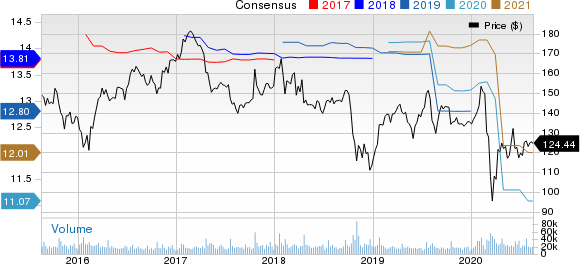IBM Rolls Out New Kubernetes-Based Red Hat OpenShift Version
International Business Machines Corporation’s IBM Red Hat buyout has helped it in enhancing containerized software capabilities and strengthening competitive position in the hybrid cloud market. The company recently rolled out its latest OpenShift version, Red Hat OpenShift 4.5.
The hybrid cloud platform — Red Hat OpenShift — aids enterprises with digital transformation. OpenShift is one of the most comprehensive and widely used Kubernetes platform.
Markedly, Red Hat OpenShift 4.5 is powered by Kubernetes 1.18. OpenShift 4.5 also includes OpenShift Virtualization platform at no extra cost.
International Business Machines Corporation Price and Consensus

International Business Machines Corporation price-consensus-chart | International Business Machines Corporation Quote
Robust Features to Boost Adoption
After being migrated to the OpenShift architecture, the virtual machine (“VM”) can be containerized later on or can be used as VMs. Consequently, customers will be able to build and deliver hybrid applications developed on containers, while running VMs simultaneously on the same platform. This will help the company’s enterprise clientele to increase agility and scale operations as per the needs of the business.
OpenShift 4.5 also boasts of single push-button deployment for a full-stack automation for VMware vSphere. With this development, administrators are required to give credentials to a vSphere deployment while the installers do the rest. This will accelerate the initial setup process as well as make management and maintenance easier.
Besides, OpenShift 4.5 provides support to deploy OpenShift clusters on Google Cloud by utilizing the pre-existing infrastructure installation model on a shared Virtual Private Cloud (VPC). Advanced cluster management for Kubernetes is available with OpenShift 4.5.
Further, OpenShift 4.5 offers support for compact 3-node clusters to deploy OpenShift into edge computing environments. This will enable enterprises to harness the benefits of IoT devices, 5G, smart sensors and edge computing platforms.
We believe that these features will boost adoption of the latest offering, as containerised applications come mainstream. This in turn, is expected to bolster revenues from Red Hat in the days ahead. Markedly, in the second quarter revenues from Red Hat totaled $1.09 billion, reflecting an increase of 17% (up 18% at cc) on a normalized basis.
Currently, more than 2,400 clients are using Red Hat and IBM’s hybrid cloud platform, and around 600 IBM Services clients are leveraging Red Hat technology. Moreover, OpenShift and Ansible have supported advancements in application and technology developments.
Momentum in Containerised Applications Bodes Well
For IBM, OpenShift 4.5 represents an opportunity to expand its customer base. Enterprises are rapidly deploying containerised applications.
Increasing usage of cloud computing especially hybrid cloud, and a fast growing IoT market are expected to significantly boost the market growth for containerised applications, per a Grand View Research report. The worldwide application container market is anticipated to grow at a CAGR of 26.5% from 2019 to 2025.
Markedly, containerization application refers to operating system level virtualization process that runs different applications without initiating the entire VM each time for each app. This offers benefits of portability, isolation and ease of management compared with virtualization.
Also, containerised apps are being utilised to run microservices application architecture. Microservices, which works with containers, inherently gain the benefits of the latter, and greatly improve efficiency.
Per an IBM blog, containerisation along with cloud computing and microservices provides more efficiency and agility to a software development lifecycle as compared with other traditional methods. As a result, organisations can scale up delivery of applications to the end-users.
Per Gartner data, more than 75% of organisations across the globe will be utilizing container applications by 2022 compared with less than 30% in 2019.
IBM with its cloud-based Kubernetes Service and Red Hat OpenShift Container Platform stands to benefit from this trend.
However, stiff competition from Google, Microsoft MSFT and Amazon Web Services is a concern.
Per Grand View Research report, cited above, increasing complexity of IoT, big data and hybrid cloud technologies is making management of workloads difficult on a single platform, which remains a challenge. Moreover, dearth of adequate bandwidth and network congestion challenges might bring about delays in data exchange from sources to the cloud and be a persistent concern.
Zacks Rank & Key Picks
IBM currently carries a Zacks Rank #4 (Sell).
Apple AAPL and Blackbaud BLKB are a couple of better-ranked stocks worth considering in the broader computer and technology sector, both flaunting a Zacks Rank #1 (Strong Buy). You can see the complete list of today’s Zacks #1 Rank stocks here.
Long-term earnings growth rate for Apple and Blackbaud is pegged at 10.7% and 7.6%, respectively.
Looking for Stocks with Skyrocketing Upside?
Zacks has just released a Special Report on the booming investment opportunities of legal marijuana.
Ignited by new referendums and legislation, this industry is expected to blast from an already robust $6.7 billion to $20.2 billion in 2021. Early investors stand to make a killing, but you have to be ready to act and know just where to look.
See the pot trades we're targeting>>
Want the latest recommendations from Zacks Investment Research? Today, you can download 7 Best Stocks for the Next 30 Days. Click to get this free report
Microsoft Corporation (MSFT) : Free Stock Analysis Report
International Business Machines Corporation (IBM) : Free Stock Analysis Report
Apple Inc. (AAPL) : Free Stock Analysis Report
Blackbaud, Inc. (BLKB) : Free Stock Analysis Report
To read this article on Zacks.com click here.
Zacks Investment Research

 Yahoo News
Yahoo News 